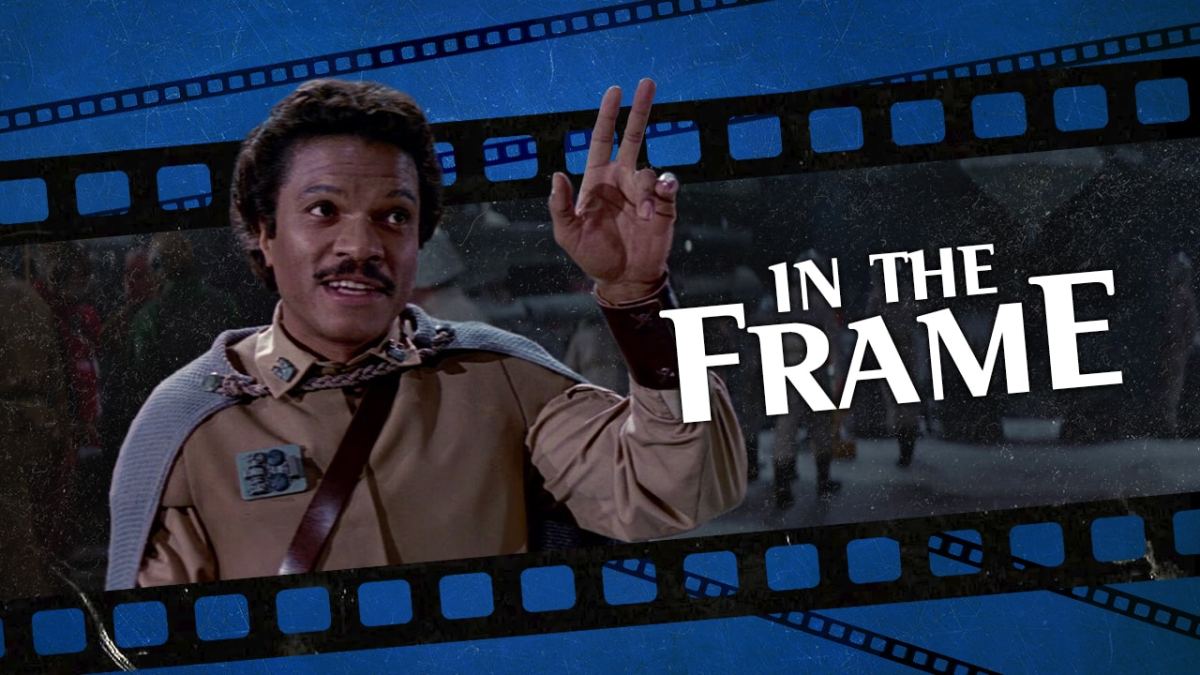Star Wars is a sprawling saga populated by legendary heroes.
Much has been written about Star Wars as an example of the Campbellian monomyth, packed with Jungian and Freudian subtext. It is a story of generational conflict, one that speaks to anxieties of the modern world, framing them in epic terms. It is a story of empires and rebellions, of secret princes and demonic villains. Everything is rendered larger than life – if not outright cartoonish.
Everything except Lando Calrissian (Billy Dee Williams). Lando is one of the most compelling characters in the entire Star Wars franchise, and he is so interesting because he largely exists outside the general mythic sweep of the saga, worlds apart from Luke Skywalker (Mark Hamill), Leia Organa (Carrie Fisher), or Han Solo (Harrison Ford). That’s his charm. Well, that and the cape.
Most of the characters in Star Wars are clearly defined archetypes. Luke is introduced as a simple (moisture) farm boy who dreams of a larger world than the one he knows. Leia first appears as a princess who is locked away in the heart of the Death Star, waiting to be rescued. Han is the dashing rogue with just a hint of danger, but who will show up when it counts.
None of this is to dismiss these characters. The actors playing those roles were immensely charming, and the characters were allowed to become more complicated and more developed as the films went on. There’s a solid argument to be made that Han Solo was never more interesting than in The Force Awakens and that Luke’s journey reached a perfect ending in The Last Jedi.
However, Star Wars draws its characters and arcs in broad terms. As interesting as it might be to pick at the shared universe, the original trilogy was built on strong moral dichotomies. The Empire was evil and the Rebel Alliance was heroic. Even though Luke grew up on a desert planet, he and Leia were often clad in white. In contrast, Darth Vader and the Emperor dressed in black.

For all his bluster, even Han Solo was self-evidently a good guy. There’s a tendency to focus on the character’s screwball antics and his occasionally grouchy demeanor, but Han would always at least try to do the right thing. He came back to help Luke at the climax of Star Wars, and he hung around with Leia long enough for Jabba the Hutt to place a bounty on his head in The Empire Strikes Back.
This is what makes Lando so interesting. Lando is actually a rogue. He is first described by Han as “a card player, gambler, scoundrel.” Han would likely describe himself in similar terms, but he’d be wrong. Han is a hero, despite his protestations. A large part of Han’s journey in The Empire Strikes Back is actually acknowledging that – admitting that, to quote a key moment, he knows.
Lando is introduced in The Empire Strikes Back as a dramatic foil and dysfunctional counterpart to Han. Put simply, Lando is the sort of amoral (and later conflicted) rogue that Han pretends to be. Much like Han worked as a smuggler outside the trilogy’s central conflict, Lando ensures that his own mining operation Cloud City operates “outside the jurisdiction of the Empire.”
Lando insists that his mining operation “is small enough not to be noticed,” which allows him to avoid picking sides. The anonymity is good for business, his customers “anxious to avoid attracting attention to themselves.” Lando is a man insulated from the turmoil outside his walls. Cloud City is one of the most beautiful and pristine environments in the original trilogy, sleek and clean.
In some ways, Lando is an embodiment of the ambiguity that creeps in around the edges of The Empire Strikes Back to complicate the clear-cut universe introduced in Star Wars. George Lucas has described Star Wars as “a film for children,” but The Empire Strikes Back pushes towards a more teenage sensibility, acknowledging that the universe is not always starkly divided into good and evil.

Lando also speaks to The Empire Strikes Back as a film of the 1980s. Chuck Klosterman has argued that the film positioned Luke as “the original Gen Xer.” Even in terms of production design, The Empire Strikes Back offers a colder and more sterile aesthetic than the “used future” of Star Wars, down to the redesign of Darth Vader’s armor to make it shinier. Lando is a product of that shift.
Lando is a small businessman trying to stay afloat while wary of government interference, one that might have been drawn to Ronald Reagan’s promises of deregulation during the 1980 election. Cloud City is a family-friendly version of the metaphors for 1980s America seen in films like A Nightmare on Elm Street or Blue Velvet, a shiny surface atop a grotesque and nightmarish core.
As played by Billy Dee Williams, Lando is suave and smooth. Williams is comfortably the most charismatic performer in the original trilogy, with only Ford giving him a run for his money. Lando jokes about being “responsible these days,” but he acts like a man without a care in the world – all flowing capes and wide grins.
However, Lando isn’t Han. Lando lacks Han’s moral code. Even Solo: A Star Wars Story understands this. While Han returned to save Luke from Vader at the climax of Star Wars, the climax of Solo has Lando (Donald Glover) abandoning Han (Alden Ehrenreich) at his moment of greatest need. In The Empire Strikes Back, Lando betrays Han and Leia to the Empire to protect his own interests.
That betrayal is a source of debate to this day. Williams argues that Lando made a pragmatic decision, acting in what he believed to be the best interests of his friends and the inhabitants of Cloud City. However, it is clear that no other major Star Wars character would have made that deal with Vader. Han would never even have considered it. No hero in an epic story ever would.

Even after Lando makes the decision to help Leia escape at the climax of The Empire Strikes Back, he is still defined as a dysfunctional counterpart to Han. In the final scenes of the film, he sits in the cockpit of the Millennium Falcon wearing clothes identical to Han’s iconic white-shirt-and-black-waistcoat combo, as if to identify Lando as an inferior copy dressed in secondhand clothes. Even when Lando tries to play the hero, it feels more like impersonation.
This sense carries over to Return of the Jedi. Lando gets to lead the assault on the second Death Star, but by process of elimination. He pilots the Millennium Falcon while Han leads the more strategically crucial mission of disarming the shield generator. Of the three overlapping threads at the climax of Return of the Jedi, Lando anchors the one that is transparently a retread of the climax of the original Star Wars; he leads a space dogfight on a Death Star and blows up the core. Even his plots are secondhand.
This is what makes Lando so interesting. He is not a mythic hero. He often seems like a guy just trying to get by. This carries over to his long-delayed return in The Rise of Skywalker, where it has been revealed (in supplementary material) that Lando’s daughter was kidnapped and enslaved by the First Order.
Lando isn’t well-served by The Rise of Skywalker, often reduced to a fan service delivery mechanism. Still, there’s something oddly perfect in that reveal. Once again, Lando is a broken mirror to Han. Han’s son, Ben (Adam Driver), was also corrupted by the First Order, but he became the monstrous Kylo Ren. Lando’s daughter, Jannah (Naomi Ackie), became an anonymous stormtrooper.
Han casts himself as a rogue, but he will always be a hero in a sprawling saga. Even when Han returns to smuggling in The Force Awakens, his son is cast as heir to Darth Vader. In contrast, Lando deals with a much more mundane trauma, one with a lot less spectacle and melodrama. In some ways, it is appropriate that the theatrical cut of The Rise of Skywalker finds no room for Lando’s pain.
Lando is perhaps the most human character in the entire Star Wars saga, a man who is neither hero nor villain. Instead, all that Lando can do is stay afloat when caught in the gravity of a mythic narrative. He also looks damn good in a cape.






Published: Mar 23, 2020 11:00 am